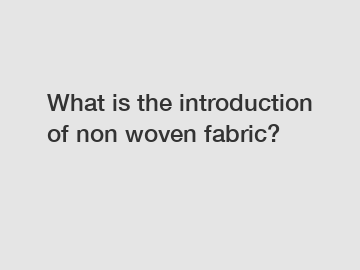What is the introduction of non woven fabric?
Huabao Product Page
Non woven fabric is a versatile and widely used material that has gained popularity in various industries. It offers a range of benefits and advantages over traditional woven fabrics, making it a preferred choice for many applications. In this article, we will explore what non woven fabric is, its characteristics, manufacturing process, and its importance in different sectors.
Understanding Non Woven Fabric:

Non woven fabric, also known as non-woven textiles, is a sheet or web-like material that is made without the use of weaving or knitting. It is produced by bonding or felting fibers together mechanically, thermally, or chemically. Unlike woven fabrics, non woven fabric does not require any yarn to be formed.
Characteristics of Non Woven Fabric:
Non woven fabric possesses various unique characteristics that make it suitable for diverse applications. Some of its key features include:
1. Durability: Non woven fabric is known for its high strength and durability. It can withstand wear and tear, making it suitable for long-lasting products.
2. Breathability: This type of fabric offers excellent breathability, allowing air and moisture to pass through. It is commonly used in medical, hygiene, and filtration applications.
3. Absorbency: Non woven fabric has excellent absorbency properties. It can soak up liquids, making it suitable for use in medical and hygiene products like diapers and wound dressings.
4. Lightweight and Softness: Non woven fabric is lightweight and soft to touch, providing comfort and ease of use in various applications.
Manufacturing Process:
The manufacturing process of non woven fabric involves three main steps: web formation, web bonding, and finishing treatments.
1. Web Formation: In this stage, fibers are collected and laid on a conveyor belt or screen. These fibers can be made from natural materials, such as cotton or wool, or synthetic materials like polyester or polypropylene. The fibers are spread and layered to form a web-like structure.
2. Web Bonding: In the bonding phase, the loose fibers are entangled or fused together to create a cohesive fabric. Some common bonding methods include mechanical (needle punching), thermal (heat bonding), or chemical (adhesive bonding).
3. Finishing Treatments: Once the fabric is bonded, it undergoes additional treatments to enhance its properties. These treatments can include dyeing, printing, embossing, or applying various coatings to provide additional functionalities like water resistance or flame retardancy.
Importance in Different Sectors:
Non woven fabric finds extensive use in a wide range of sectors due to its unique properties and advantages. Some key industries that rely on non woven fabric are:
1. Healthcare and Hygiene: Non woven fabric is widely used in healthcare and hygiene products like surgical gowns, masks, wound dressings, and sanitary napkins. It provides a barrier against bacteria and viruses while being breathable and comfortable.
2. Agriculture: Non woven fabric is used in agriculture to control weed growth, protect crops from pests, and improve soil moisture retention.
3. Packaging: Non woven fabric is an excellent choice for packaging materials due to its strength, durability, and flexibility. It is used for making bags, wrapping materials, and protective covers.
4. Automotive: Non woven fabric is utilized in the automotive industry for upholstery, floor coverings, soundproofing, and air filters.
Closing Paragraph:
In conclusion, non woven fabric is a versatile material that offers significant advantages over traditional woven fabrics. Its durability, breathability, absorbency, and lightweight nature have made it a popular choice in various industries. From healthcare and hygiene to agriculture and automotive, non woven fabric plays a crucial role in providing effective solutions. If you have any questions or require further information about non woven fabric, please do not hesitate to contact us.
For more information, please visit type 5 coveralls.



